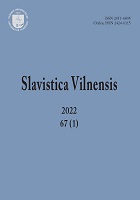Українська паралель XVIII століття до балтського міфу про Совія
An 18th Century Ukrainian Parallel to the Baltic Myth of Sovius
Author(s): Kostyantyn RakhnoSubject(s): Ukrainian Literature, Theory of Literature, Sociology of Literature
Published by: Vilniaus Universiteto Leidykla
Keywords: legend about Sovius; chronograph; Baltic mythology; Ukrainian literature of the Baroque period; interlude;
Summary/Abstract: The article is devoted to the story of Sovius, which is contained in the Western Ruthenian translation of the 13th century Chronograph by John Malalas. This text of 1261 reflects the Baltic mythological tradition and has long been the subject of academic study. The mythological character Sovius is described as the guide of the dead on the path to Hell. After a series of experiments on himself, he introduces the custom of burning bodies and making sacrifices to the pagan gods. Comparative studies reveal the idea of him as being the first to die, opening the way to the afterlife for the next generation of people and becoming the ruler of this underworld. Apparently the worship of the Baltic deities arose from Sovius’ stories to his son about the experience of dying. He is the common ancestor of the Lithuanians, Yatvyags and Prussians, who practice cremation of the dead. After relating the tale of Sovius, the chronographer condemns the pagan beliefs and customs of the Lithuanian neighbours. Certain elements of this myth have been preserved in the interlude within the Easter drama of the Ukrainian cultural figure and educational writer, the priest-monk Mytrofan Dovgalevsky. However, this Ukrainian text describes a Belarusian. The father dies, his sons resurrect him and in a comical style the father tells his sons what he had to go through in that underworld. This story reflects the popular, semi-pagan perception of Christian images, which according to Dovgalevsky enhances the comic effect.
Journal: Slavistica Vilnensis
- Issue Year: 67/2022
- Issue No: 1
- Page Range: 58-68
- Page Count: 11
- Language: Lithuanian

